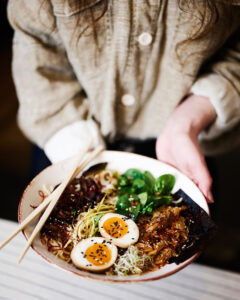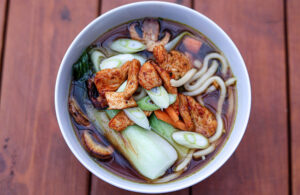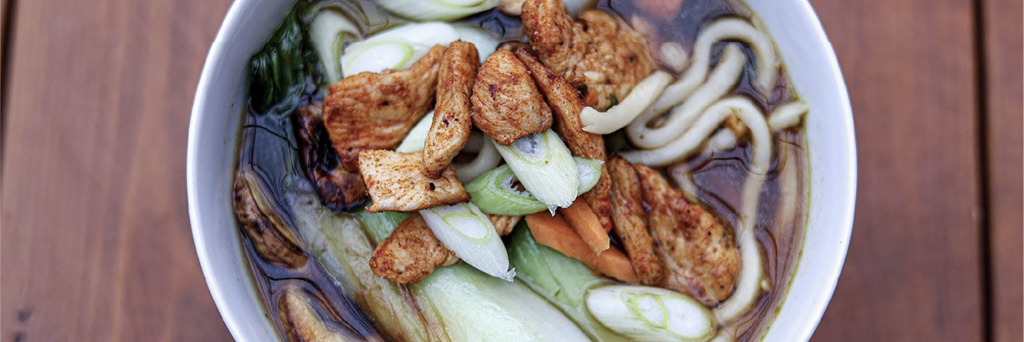Ramen, those delicious Japanese noodles bathed in a savoury broth, have conquered taste buds the world over. However, behind this apparent simplicity lies a rich and fascinating history that goes back several centuries. From ancient China to modern Japan, ramen has come a long way to become one of the most emblematic dishes in Asian cuisine.
Ancestral origins in China
The history of ramen begins in China, where similar noodles were eaten as early as the third century AD. Originally made from wheat flour and salt, these noodles were often dried to preserve them. Over time, these noodles evolved into "lamian 老麺", hand-drawn noodles, illustrating the intricate art of noodle making.
While noodles have existed in a variety of forms, Ramen noodles are differentiated from others by the use of Kansui 鹹水, a variant of sodium carbonates. The latter acts on the gluten in the wheat flour to create the unique texture of Ramen noodles.
The appearance of ramen in Japan
Ancient documents indicate that the privileged in Japan were already enjoying a noodle dish called "Kei Tai Menk経帯麺" in the 13th century. Noodles were prepared in much the same way as they are today.
In 1858, Japan opened its borders after declaring the end of the samurai era. Cultural exchanges then encouraged the Chinese to come to Japan and bring with them their culinary culture, including ramen.
However, the real turning point came in 1910, when the very first ramen restaurant, Rai Rai Ken, opened in Asakusa, Tokyo. It is said that 12 Chinese chefs were specially hired to prepare the dishes and the restaurant became so popular that 3,000 portions of Ramen were served every day!
The next step was the Tokyo earthquake of 1923, which caused considerable damage, decimating everything, including the fledgling Chinese restaurants. But businesses revived by offering Ramen on their makeshift carts, or Yatai 屋台. Chefs owned their kitchens on a trolley and went out to sell on the street.
This practice continued until the end of the Second World War. Until then, ramen was often referred to as "Shina Soba", or "Chinese noodles".
After the Second World War, as economic growth accelerated, ramen culture spread to other regions of Japan. Each region has its own food culture and specialities. Ramen naturally reflects these regional characteristics, and the type of noodle varies according to the type of broth used.

Ramen evolution
Over the decades, ramen has gone from being a simple street food to a veritable culinary phenomenon. Chefs began experimenting with new flavours, bold fillings and innovative cooking techniques. Ramen has become a blank canvas for creativity, with vegetarian versions, seafood ramen and even variants fusing international influences. There are even three Japanese ramen restaurants with Michelin stars. Michelin Guide.
Many non-Japanese chefs trained in Japan are opening ramen restaurants around the world. They are exploring their own style, using local ingredients while respecting the principles of ramen learned in Japan.
Noodle-making machines

Many ramen restaurants order their own noodles from manufacturers, using their own recipes. But when ramen noodle-making machines became available in the 1990s, independent restaurants began making their own fresh noodles on the premises. They allow the chef to be creative and explore new horizons.
Sushi Robots offers different types of ramen machines.
Today and beyond
In 2023, the ramen market in Europe continues to grow and gain in popularity. Once considered an exotic dish, ramen has become a staple food in many European countries, attracting a wide range of consumers, from young culinary adventurers to lovers of traditional Asian flavours.
Offer diversification
Local and international companies also offer pre-packaged ramen options in supermarkets and grocery shops. These products offer added convenience for consumers who want to enjoy the ramen experience at home.

The influence of fusion cuisine
Fusion cuisine also continues to play an important role in the European ramen market. Chefs are experimenting by mixing ingredients and flavours from different cultures. You can find fusion ramen that incorporates elements of European, Mediterranean or even Latin American cuisine, creating unique and intriguing dishes.
Growth in vegetarian and vegan options
The growing demand for healthier and sustainable food options has also stimulated the growth of vegetarian and vegan ramen in Europe. Restaurants and food brands are responding to this demand by offering vegetable-based broths, plant-based proteins and nutrient-rich fillings.
In conclusion, the history of ramen is a saga that spans time and continents. From their humble origins in China to their transformation into a complex and varied dish in Japan, ramen embodies both tradition and innovation. These delicious noodles remind us that cooking can be a powerful vehicle for cultural sharing and culinary creativity. So the next time you dip your chopstick into a steaming bowl of ramen, remember that you are holding in your hands a culinary heritage that has travelled through the centuries to reach your plate.


